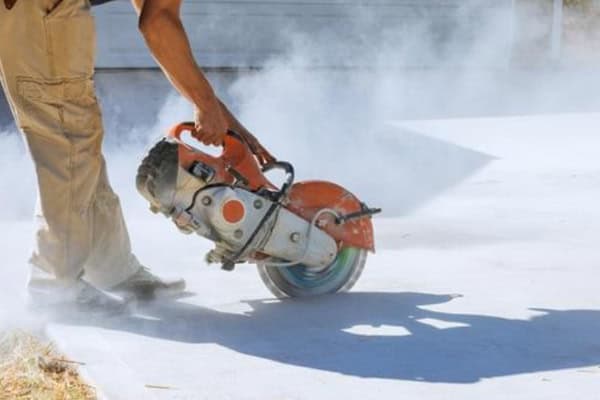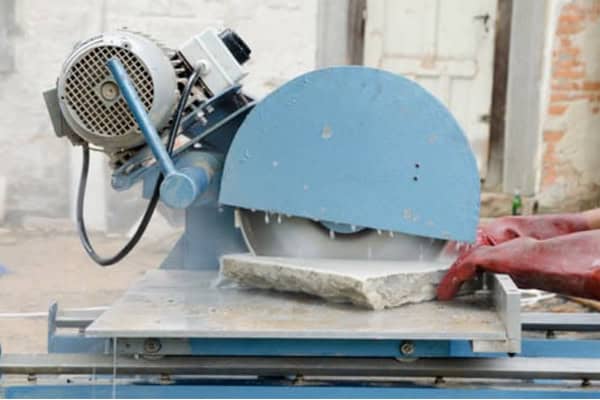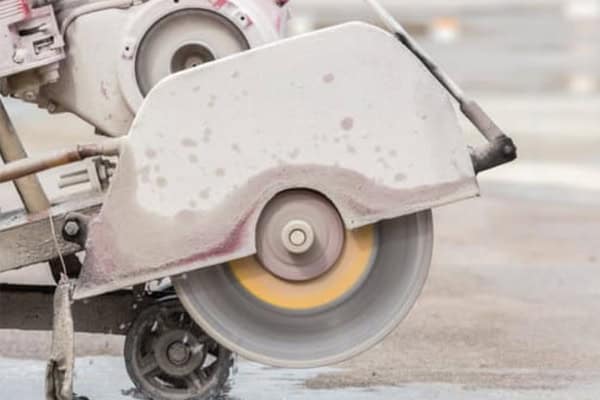
Cutting through tough materials can be a challenge, but with the right tools, it’s achievable. Today, let’s dive into what a diamond blade can handle and how it can make your projects easier.
Diamond blades are incredibly versatile and can cut through a variety of hard materials with ease. From slate and rock to certain ceramics, these blades offer precision and durability. Whether you’re a DIY enthusiast or a professional, understanding what a diamond blade can cut will help you choose the right tool for your needs.
Let’s explore the different materials you can tackle with a diamond blade.
Will a Diamond Blade Cut Slate?
Ever wondered if a diamond blade is the right choice for cutting slate? Let’s find out.
Yes, a diamond blade can efficiently cut slate. Its hard abrasive particles make it ideal for slicing through this dense, fine-grained stone without causing excessive chipping or cracking.

Using a diamond blade to cut slate is a game-changer for many construction and renovation projects. Slate, known for its durability and aesthetic appeal, is often used in roofing, flooring, and countertops. However, cutting slate can be tricky due to its hardness and tendency to chip. That’s where diamond blades come into play.
Why Choose a Diamond Blade for Slate?
Diamond blades are embedded with industrial-grade diamonds that grind through slate with minimal effort. Unlike traditional blades, they provide a cleaner cut1 and reduce the risk of damaging the material. This precision is crucial when working on projects where the appearance of the slate is important.
Practical Applications
For instance, when installing slate countertops, a diamond blade ensures that each cut is smooth and precise, fitting perfectly into your design. Similarly, in roofing, it allows for accurate cuts around vents and edges, ensuring a watertight seal.
Maintenance and Safety Tips
To get the most out of your diamond blade, proper maintenance is essential. Regularly clean the blade to remove debris and check for any signs of wear. Always wear appropriate safety gear, such as gloves and eye protection, to prevent injuries while cutting.
| Dica | Descrição |
|---|---|
| Regular Cleaning | Keeps the blade free from debris for optimal performance. |
| Proper Storage | Store in a dry place to prevent rust and damage. |
| Safety Gear | Always use gloves and goggles for protection. |
By understanding the benefits and proper usage of diamond blades for slate, you can achieve professional results with ease.
The Science Behind Diamond Blades Cutting Slate
Diamond blades are not just sharp; they are engineered with precision. The diamonds embedded in the blade act as an abrasive, effectively grinding through slate. This process generates minimal heat, reducing the risk of thermal damage to the material. Additionally, the continuous contact between the diamond particles and the slate ensures a consistent and clean cut every time.
Common Mistakes to Avoid
Cutting slate with a diamond blade requires attention to detail. Here are some common mistakes to watch out for:
- Using the Wrong Blade: Not all diamond blades are created equal. Ensure you use a blade specifically designed for slate.
- Applying Excessive Pressure: Let the blade do the work. Too much pressure can cause the blade to overheat or the slate to crack.
- Ignoring Safety Precautions: Always wear protective gear to safeguard against debris and potential accidents.
Personal Anecdote
I remember working on a renovation project where the existing slate flooring needed to be replaced. The old blades we were using kept chipping the slate, ruining the aesthetic of the new installation. Switching to a diamond blade made all the difference. The cuts were clean, precise, and the slate pieces fit perfectly into the new design. It was a relief to see the project come together without the frustration of damaged materials.
Will a Diamond Blade Cut Rock?
Rock can be stubborn, but is a diamond blade up to the task? Absolutely.
Diamond blades are designed to cut through various types of rock, including granite and basalt. Their durability and sharpness make them perfect for heavy-duty cutting tasks.

Cutting rock requires a blade that can withstand immense pressure and friction. Diamond blades are engineered to handle such demands, making them a top choice for both small-scale projects and large construction jobs.
Types of Rock Suitable for Diamond Blades
Diamond blades can handle a wide range of rocks. Granite, with its coarse grains, and basalt, known for its density, are both easily cut with a diamond blade. This versatility makes them invaluable for various applications, from landscaping to structural construction.
Advantages Over Other Blades
Unlike carbide blades, diamond blades maintain their sharpness longer when cutting rock. This means fewer blade changes and more efficient work. Additionally, the precision of diamond blades reduces the risk of cracking or breaking2 the rock during cutting.
Best Practices for Cutting Rock
To ensure the best results, follow these practices:
- Use Water Cooling: Keeps the blade cool and reduces dust.
- Steady Pressure: Apply consistent pressure to avoid uneven cuts.
- Proper Blade Selection: Choose the right blade type based on the rock hardness.
| Best Practice | Why It Matters |
|---|---|
| Water Cooling | Prevents overheating and extends blade life. |
| Consistent Pressure | Ensures smooth and even cuts. |
| Blade Selection | Matches blade properties with rock type. |
Deep Dive: Understanding Rock Types and Cutting Techniques
Different rocks have unique properties that affect how they should be cut. For example, granite is highly durable and resists weathering, making it ideal for countertops and outdoor structures. Basalt, on the other hand, is dense and dark-colored, often used in construction and as a decorative stone.
When cutting granite, a diamond blade with a higher diamond concentration is recommended to handle the stone’s toughness. Basalt requires a blade with strong bonding to prevent the diamonds from dislodging during cutting. Understanding these nuances ensures that you select the right blade for the specific type of rock you’re working with.
Environmental Considerations
Cutting rock generates significant dust and noise, which can impact the environment and surrounding areas. Using water cooling not only extends the blade’s life but also minimizes dust production. Additionally, adhering to local regulations regarding noise and waste disposal ensures that your project remains environmentally responsible.
Case Study: Building a Granite Patio
In a recent project, I was tasked with building a granite patio for a client. The process involved cutting large granite slabs to fit the designated area precisely. Using a diamond blade made the cutting process smooth and efficient. The clean edges enhanced the overall aesthetic of the patio, and the reduced chipping meant less cleanup and rework. The client was thrilled with the final result, highlighting the importance of using the right tools for the job.
Will a Diamond Blade Cut Rebar?
You might have heard that diamond blades are the ultimate cutting tools, but when it comes to rebar, there’s a catch.
Actually, diamond blades are not suitable for cutting rebar or other metals like iron and stainless steel. These materials require specialized blades designed specifically for metal cutting.

Rebar, or reinforcing bar, is essential in construction for strengthening concrete structures. Cutting rebar typically involves using tools like reciprocating saws with metal-cutting blades or specialized rebar cutters. Attempting to cut rebar with a diamond blade can lead to blade damage and ineffective cuts, as diamond blades are primarily designed for non-metallic materials.
Why Diamond Blades Aren’t Ideal for Rebar
Diamond blades are optimized for cutting stone, tile, and similar materials. The hardness and tensile strength of metals like rebar require a different type of blade that can handle the high torque and abrasive nature of metal cutting. Using a diamond blade on rebar not only risks damaging the blade but also poses safety hazards.
Recommended Tools for Cutting Rebar
For cutting rebar, consider the following tools:
- Reciprocating Saws: Equipped with metal-cutting blades, they provide the necessary power and precision.
- Angle Grinders: With appropriate metal blades, they can efficiently slice through rebar.
- Hydraulic Rebar Cutters: Ideal for heavy-duty cutting tasks in construction environments.
Safety Considerations
When cutting rebar, always prioritize safety:
- Wear Protective Gear: Gloves, safety glasses, and ear protection are essential.
- Secure the Rebar: Ensure the material is firmly anchored to prevent movement.
- Use Proper Techniques: Follow manufacturer guidelines to operate tools safely and effectively.
| Recommended Tool | Benefit |
|---|---|
| Serra Alternada | Versatile and easy to maneuver for various cuts. |
| Angle Grinder | High speed and efficiency for quick cuts. |
| Hydraulic Cutters | Powerful and reliable for large-scale projects. |
Exploring Alternatives for Metal Cutting
While diamond blades aren’t suitable for cutting metals, there are several alternatives that can get the job done efficiently:
- Cold Saws: These use a circular blade with fine teeth to make precise cuts in metal.
- Band Saws: Ideal for cutting rebar into specific lengths with minimal waste.
- Plasma Cutters: Offer fast and accurate cuts for thick metal sections.
Each of these tools has its own set of advantages and is suitable for different types of metal cutting tasks. Selecting the right tool depends on the specific requirements of your project, including the type and thickness of the metal, as well as the desired precision3.
Personal Insight
I once attempted to cut rebar using a diamond blade, thinking it would be versatile enough for the task. To my surprise, the blade quickly became dull and started to crack, making the job frustrating and unsafe. It was a valuable lesson in understanding the limitations of tools and the importance of selecting the right blade for the material at hand.
Will a Diamond Blade Break?
With all the tough materials they cut, can diamond blades themselves break? Let’s explore.
Diamond blades are highly durable, but like any tool, they can break if misused. Proper handling and maintenance are key to preventing breakage and ensuring longevity.

While diamond blades are built to handle hard materials, they aren’t indestructible. Factors such as improper use, overloading, or using the wrong type of blade for the material can lead to breakage. Understanding how to care for and use your diamond blade correctly can significantly reduce the risk of damage.
Common Causes of Diamond Blade Breakage
- Overheating: Excessive heat can weaken the blade, leading to cracks or complete breakage.
- Improper Use: Using the wrong blade for the material can cause undue stress.
- Lack of Maintenance: Accumulated debris can imbalance the blade during operation.
- Physical Damage: Dropping or striking the blade can cause chips or cracks.
Preventative Measures
To keep your diamond blade in top condition:
- Use Correct Blade: Ensure the blade is suitable for the material you’re cutting.
- Cool Properly: Utilize water cooling to prevent overheating.
- Regular Inspection: Check for signs of wear or damage before each use.
- Proper Storage: Store blades in a dry, safe place to avoid physical damage.
Maintenance Tips
Regular maintenance not only prolongs the life of your diamond blade but also ensures safe operation:
- Clean After Use: Remove any residue or debris after each cutting session.
- Sharpen as Needed: If the blade starts to dull, consider sharpening or replacing it.
- Avoid Hard Impacts: Handle blades with care to prevent accidental damage.
| Cause of Breakage | Preventative Measure |
|---|---|
| Superaquecimento | Use water cooling and avoid prolonged use. |
| Improper Use | Match blade type with the material being cut. |
| Lack of Maintenance | Regularly clean and inspect the blade. |
| Physical Damage | Handle and store blades carefully. |
Deep Dive: Understanding Blade Composition and Durability
Diamond blades are crafted by embedding diamond particles into a metal matrix. The quality and concentration of these diamonds determine the blade’s cutting efficiency and lifespan. Higher diamond concentrations result in faster cutting speeds and longer blade life, especially when dealing with harder materials.
However, the bond between the diamond particles and the metal matrix is equally important. A strong bond ensures that the diamonds remain securely in place during cutting, preventing premature wear and tear. Understanding the composition4 of your diamond blade can help you select the right blade for your specific cutting needs, ensuring optimal performance and longevity.
Temperature Management
Managing the temperature during cutting is crucial to prevent blade damage. Overheating can cause the metal matrix to soften, reducing the blade’s structural integrity. Using water cooling systems not only helps in maintaining a stable temperature but also reduces dust generation, creating a safer and cleaner working environment.
Personal Anecdote
During a large-scale construction project, we faced frequent blade breakages due to prolonged use without proper cooling. After switching to a water-cooled diamond blade and implementing regular maintenance checks, the frequency of breakages dropped significantly. This change not only saved time and money but also improved overall project efficiency.
Enhancing Your Cutting Projects with Diamond Blades
Now that we’ve covered what diamond blades can and cannot do, let’s explore how to maximize their potential in your cutting projects.
Using diamond blades effectively can transform your cutting experience, making it smoother, safer, and more efficient.

Choosing the Right Diamond Blade
Selecting the right diamond blade is the first step towards successful cutting. Consider the following factors5:
- Material Type: Ensure the blade is designed for the material you intend to cut.
- Blade Size: Choose a blade size that matches your cutting equipment.
- Diamond Concentration: Higher concentrations are suitable for harder materials.
- Bond Type: The bond controls how quickly the diamond wears away, impacting cutting speed and blade life.
Optimizing Cutting Techniques
Proper cutting techniques can enhance the performance of your diamond blade:
- Start Slow: Begin cutting at a slower speed to establish a clean edge.
- Maintain Steady Pressure: Consistent pressure ensures an even cut and prevents blade binding.
- Use Appropriate Speed Settings: Match the speed settings of your equipment to the blade’s specifications.
Safety First
Safety should always be a priority when using diamond blades:
- Wear Protective Gear: This includes gloves, safety glasses, and hearing protection.
- Ensure Proper Ventilation: Cutting can generate harmful dust and fumes.
- Follow Manufacturer Guidelines: Adhere to all instructions and recommendations provided by the blade manufacturer.
Troubleshooting Common Issues
Even with the best blades and techniques, you might encounter some issues:
- Blade Slippage: Ensure the blade is securely fastened and properly aligned.
- Uneven Cuts: Check for consistent pressure and steady movement during cutting.
- Excessive Dust: Use water cooling or dust suppression systems to minimize dust.
Personal Insight
In my experience, the key to successful cutting lies in preparation and attention to detail. Before starting any project, taking the time to select the right blade and setting up your equipment properly can save you a lot of hassle down the line. It’s like preparing for a long journey; the better your preparations, the smoother the trip.
Advanced Techniques for Professionals
For those looking to take their cutting projects to the next level, consider these advanced techniques:
- Precision Cutting: Use guides and jigs to achieve highly accurate cuts.
- Dual Blade Systems: Employing two blades can increase cutting efficiency and reduce wear.
- Automated Cutting Machines: These machines can handle repetitive tasks with high precision, ideal for large-scale projects.
Incorporating Technology
Modern technology offers several tools to enhance your cutting projects:
- Blade Monitoring Systems: These systems can track blade performance and predict maintenance needs.
- Dust Extraction Systems: Advanced dust extraction can significantly improve air quality and reduce health risks.
- Smart Cutting Tools: Tools equipped with sensors can adjust cutting parameters in real-time for optimal performance.
Sustainability and Efficiency
Using diamond blades can also contribute to more sustainable and efficient projects:
- Reduced Waste: Precision cuts mean less material waste.
- Longer Blade Life: Durable blades require fewer replacements, reducing waste and costs.
- Energy Efficiency: Efficient cutting techniques can lower energy consumption, benefiting both your wallet and the environment.
Personal Story
I recall a project where we needed to cut intricate patterns into granite for a high-end kitchen countertop. Using a precision-guided diamond blade, we achieved flawless results that impressed the client and showcased the blade’s capabilities. This experience highlighted how the right tools can elevate the quality of your work and exceed client expectations.
Conclusão
Diamond blades are a versatile and reliable choice for cutting a wide range of materials. With proper use and maintenance, they can enhance the efficiency and quality of your projects.
-
Understand the technology behind diamond blades and why they produce cleaner, smoother cuts compared to regular blades, which is essential for achieving high-quality results. ↩
-
Give users a deeper understanding of how cutting techniques and tools like diamond blades can help minimize rock breakage, leading to more efficient and precise cuts. ↩
-
Precision is a critical factor in metal cutting. Help users understand its significance in achieving high-quality results and ensuring the right tool is selected for the job. ↩
-
Help users explore how higher concentrations of diamonds improve cutting efficiency and extend blade life. This provides more context on how diamond concentration plays a role in blade selection, especially for harder materials. ↩
-
Help users dive deeper into specific aspects, such as material type, blade size, diamond concentration and bond type. ↩